Baron Fig notebooks have been around for a while, and they’ve won lots of fans ever since making a splashy Kickstarter debut in 2013. I’d never tried one of their notebooks until now, thanks to the company kindly providing me with a sample. Does it live up to all the hype? Let’s take a look!
I received the original Confidant notebook, in their Flagship size, aka medium (5.4 x 7.7″). It comes in a shrink-wrapped box, which makes for a very classy presentation if you are giving it as a gift. It also allows most of the branding info to be extensively presented on the box, as well as on a pamphlet inside the box, leaving the notebook itself with a very clean and minimalist look.
I don’t tend to use this size of notebook very often these days, but I like the proportions they’ve chosen for the Flagship. The larger “Plus” size at 7×10″ also looks nice. It would be nice if they added an 8.5 x 11″ version so standard letter-size sheets could be tucked in. Unfortunately, for their “Pocket” size, they went with 3.5 x 5″, which always seems too short and stubby to me compared to 3.5 x 5.5″. Baron Fig’s marketing says they have designed their notebooks to have “more breathable (and usable) space than leading notebooks.” In the medium size, Baron Fig has 41.6 square inches per page, while a comparable Moleskine has 42.3 square inches per page. The Blackwing Slate I’ve shown for comparison has 46.7 square inches per page. Leuchtturm has 47.4 square inches. So Baron Fig actually has less space than a lot of leading notebooks. (I’m calculating this with cover dimensions here, and not getting into subtracting for the width of the overhang, but that would just put Moleskine and Leuchtturm a little more ahead.) I suppose you can argue that the medium size is more “breathable” and “usable” because it is wider rather than taller and some of the space in the gutter might not be used. But in the case of the pocket size, it’s the same width but shorter, so that argument goes out the window. Size and shape are a matter of personal preference but it is misleading to claim you’re getting more page space when you aren’t.
A pocket size Moleskine is also shown below for comparison.
The notebook feels great in the hand due to the cloth binding. I’m surprised they don’t tout this feature more– nowhere in their descriptive info does it say anything other than “hardcover.” To me, a full cloth binding is an upscale and elegant feature that a lot of other brands don’t have. (I also have to say that a cloth binding is an actual, factual attribute a buyer is likely to take into consideration when choosing a notebook, rather than somewhat overblown marketing verbiage like “From the very beginning we’ve had to ask ourselves to define and redefine what a notebook is. We came to the conclusion that it’s a means to something greater than itself—a means of creating.” )
I received a light grey notebook, and a darker charcoal grey is also available. It’s a limited palette, but I like it. (Reminds me of the Bindewerk Linen Notebook color scheme.) There is no elastic closure or back pocket, but there is a ribbon marker. It’s a nice wide ribbon, but it is quite short– I don’t like ribbons to be way too long, but another half inch or so would make it a little easier to grab. Also, the ribbon is yellow. The grey/yellow color scheme seems to be popular these days but is not totally my favorite– it always makes me think of the seats on Lufthansa planes.
The cover boards are nice and solid without being too thick. There is more cover overhang than I prefer but it bothers me less because everything is even all the way around and the corners are neatly folded and tucked. The grain of the cloth is slightly on the diagonal to the edges of the notebook– this is not a functional problem at all but aesthetically it’s nicer when it’s parallel. An interesting difference is that the binding is glued down on the spine, so it tucks in when you open the notebook, rather than bowing out as most notebooks do. The notebook is said to open flat, and in theory this spine design should help it do that, but I would not call this opening 100% flat. Pretty close, but some other brands open flatter. The glued-down spine also seems to lead to some lumpiness in the binding there, but that didn’t particularly bother me.
Inside the front cover, you get nice grey endpapers with a simple box. You can write your info in there, or just enjoy it as a design element, like the suggestion of a book plate. The inside back cover has one line of very subtle brand info.
My notebook has lined pages, bright white with a medium ruling (7mm). (Plain and dot grid are also available, but not squared.) The paper feels fairly smooth but not as smooth as Moleskine, Clairefontaine or Rhodia paper. It also feels a bit heavier than Moleskine, but the actual paper weight is not specified. (In reading some other reviews of the Confidant from over the last couple of years, I noticed people saying it was 100 GSM, or 90 GSM. And their performance with fountain pens, while not always perfect, seemed to be better than mine. This makes me wonder if Baron Fig has downgraded their paper recently, since their product information no longer specifies the paper weight.)
It feels quite nice to write on, but unfortunately, wetter inks and fountain pens are a pretty big problem and a lot of pens bleed through. The bleedthrough is definitely worse than most notebooks I’ve reviewed, just as bad and maybe even a little worse than Moleskines I’ve tested in comparison. A few inks feathered a little too. On the upside, I think there is slightly less show-through than average. If you use fountain pens, beware, but as with Moleskine, you’ll be ok if you stick to gel ink rollerball pens in finer widths.
Back to the positives, though: they plant a tree for every notebook sold, and if you are into collecting limited editions, they release those pretty regularly. The latest “Lock and Key” design is particularly attractive. AND best of all, Baron Fig’s prices are actually quite good compared to other brands, with free shipping on orders of $25 and up from their online store.
Hardcover clothbound Baron Fig Confidant:
Small $12.00
Medium $18.00
Large $22.00
And you get 5% off if you buy 2, and 10% off if you buy 3.
Even without the additional discount for multiples, that’s a good few dollars cheaper than Moleskine or Leuchtturm hardcovers, which are $14.95/$19.95/$24.95 in small/medium/large.
Baron Fig also offers the Vanguard, a 72-page stitched-spine softcover sold in 3-packs:
Small $9.00
Medium $12.00
Large $15.00
Compare this to Field Notes pocket size 3-packs at $9.95-12.95, and medium size 2-packs at $12.95. Moleskine Cahier 3-packs are $9.95/$13.95/$19.95 in small/medium/large.
To wrap this up, I have to say it’s really disappointing when there is so much to like about a notebook and then the paper is a let-down, especially with a brand that trumpets how they have designed and redesigned their products in response to feedback from “the community.” Did the community really not care about pens bleeding through the paper? The question has arisen, as this appears in their FAQ:
Is your notebook paper fountain pen friendly?
All of our notebooks are specifically designed for ideation. This means that our goal is to have a large amount of pages per book, as opposed to only a few thick pages. We have found that our paper works well with many fountain pens, depending on the nib width and flow.
Sorry, but other notebook makers have figured out to accomplish ideation in notebooks with 192 pages (or more, or less) that work better with fountain pens.
And what has the community feedback been on price, and packaging? I think it is great that they have managed to keep the price lower than their competition, but I have to wonder if they could save a lot of money by ditching the fancy box– enough to upgrade the paper?
I think I’ve always been one of the more forgiving reviewers when it comes to paper because my everyday pens have always been fine point gel inks that work fine with almost anything. And if this notebook didn’t come with such big claims about being designed and engineered and iterated to be the best reinvented wheel ever, I’d be more likely to shrug off the paper issues. But more and more people seem to be using fountain pens and markers for bullet journaling and such, and it seems a shame not to better accommodate those users.
Bottom line– the Baron Fig Confidant is a very nice, well-priced notebook that will work well for many people, and it comes soooo close to being a notebook I could love. I’d have to see the pocket size version in person to be sure, but I think if they were 3.5 x 5.5″ and had better paper, I’d probably buy a pile of them (you know, because I am a little light on spare notebooks right now). But as it is, I’m afraid I won’t be jumping on the Baron Fig bandwagon.

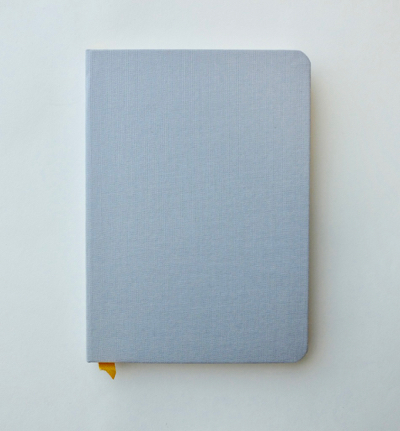
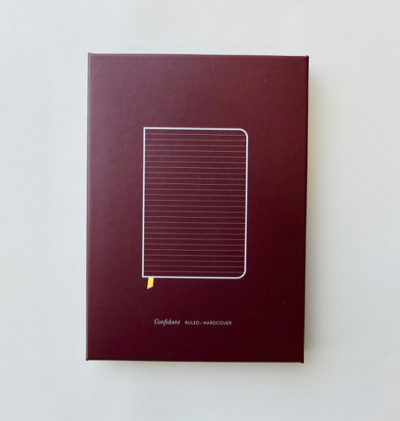
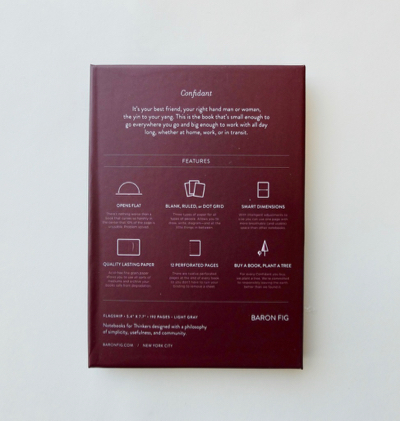
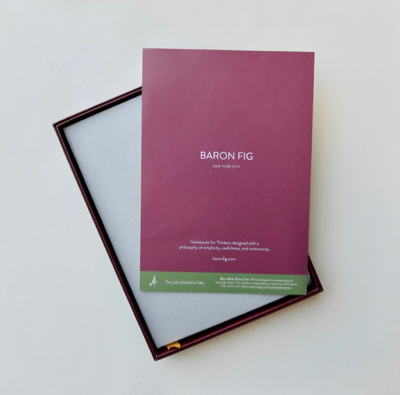

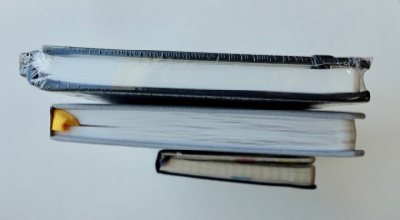
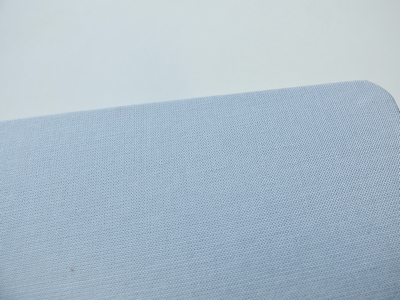
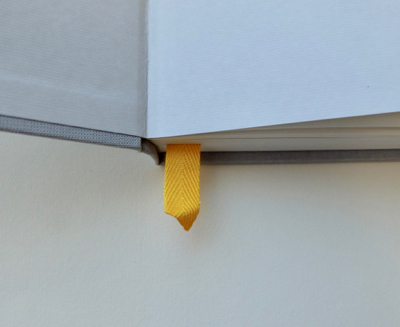




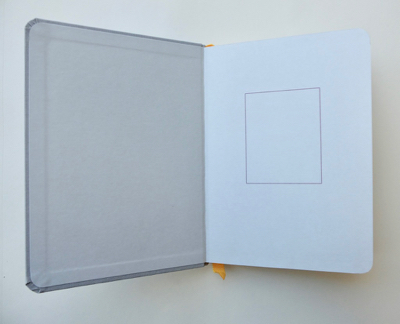
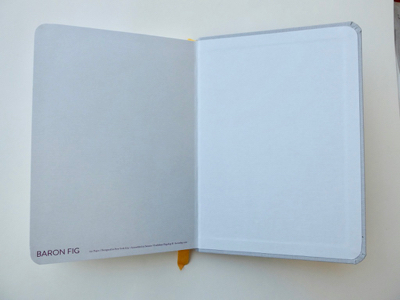

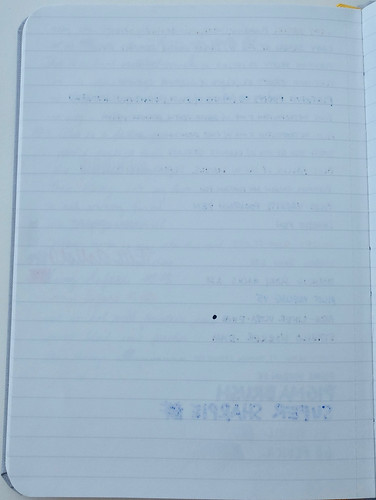

I wonder if you got one from their old stock, which had a different paper in it. . .? When I got a newer one, I found the paper to be much better than the first one I got (when they first came out) — more tolerant of juicy fountain pens, and very pleasant with pencil, too. Or maybe you got an even newer one — and it’s changed back to a crappier paper! :-(
– Tina